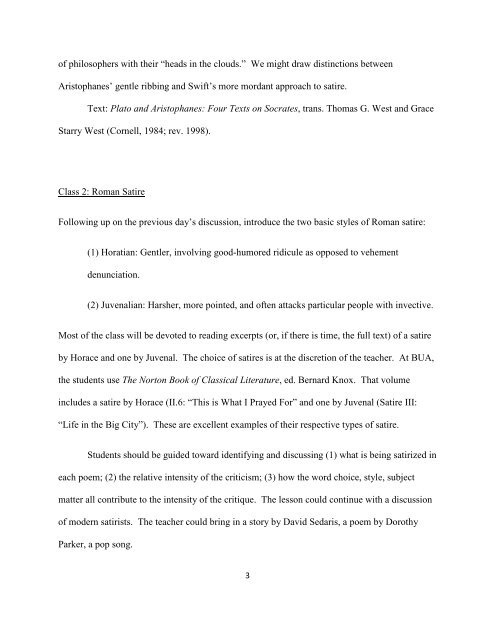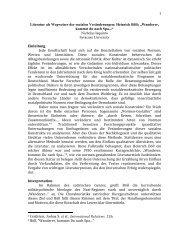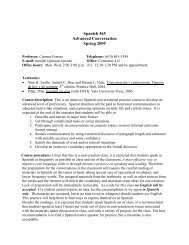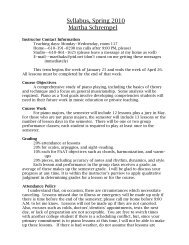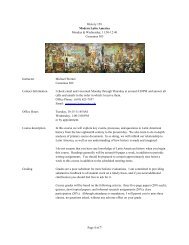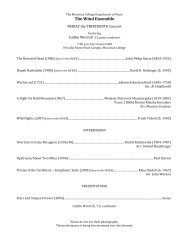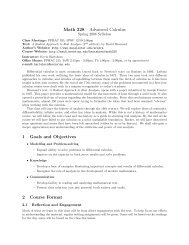Satire in the 18th Century NEH Summer Institute ... - Moravian College
Satire in the 18th Century NEH Summer Institute ... - Moravian College
Satire in the 18th Century NEH Summer Institute ... - Moravian College
Create successful ePaper yourself
Turn your PDF publications into a flip-book with our unique Google optimized e-Paper software.
of philosophers with <strong>the</strong>ir “heads <strong>in</strong> <strong>the</strong> clouds.” We might draw dist<strong>in</strong>ctions between<br />
Aristophanes’ gentle ribb<strong>in</strong>g and Swift’s more mordant approach to satire.<br />
Text: Plato and Aristophanes: Four Texts on Socrates, trans. Thomas G. West and Grace<br />
Starry West (Cornell, 1984; rev. 1998).<br />
Class 2: Roman <strong>Satire</strong><br />
Follow<strong>in</strong>g up on <strong>the</strong> previous day’s discussion, <strong>in</strong>troduce <strong>the</strong> two basic styles of Roman satire:<br />
(1) Horatian: Gentler, <strong>in</strong>volv<strong>in</strong>g good-humored ridicule as opposed to vehement<br />
denunciation.<br />
(2) Juvenalian: Harsher, more po<strong>in</strong>ted, and often attacks particular people with <strong>in</strong>vective.<br />
Most of <strong>the</strong> class will be devoted to read<strong>in</strong>g excerpts (or, if <strong>the</strong>re is time, <strong>the</strong> full text) of a satire<br />
by Horace and one by Juvenal. The choice of satires is at <strong>the</strong> discretion of <strong>the</strong> teacher. At BUA,<br />
<strong>the</strong> students use The Norton Book of Classical Literature, ed. Bernard Knox. That volume<br />
<strong>in</strong>cludes a satire by Horace (II.6: “This is What I Prayed For” and one by Juvenal (<strong>Satire</strong> III:<br />
“Life <strong>in</strong> <strong>the</strong> Big City”). These are excellent examples of <strong>the</strong>ir respective types of satire.<br />
Students should be guided toward identify<strong>in</strong>g and discuss<strong>in</strong>g (1) what is be<strong>in</strong>g satirized <strong>in</strong><br />
each poem; (2) <strong>the</strong> relative <strong>in</strong>tensity of <strong>the</strong> criticism; (3) how <strong>the</strong> word choice, style, subject<br />
matter all contribute to <strong>the</strong> <strong>in</strong>tensity of <strong>the</strong> critique. The lesson could cont<strong>in</strong>ue with a discussion<br />
of modern satirists. The teacher could br<strong>in</strong>g <strong>in</strong> a story by David Sedaris, a poem by Dorothy<br />
Parker, a pop song.<br />
3


